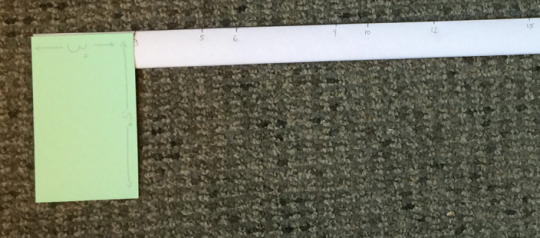Warmup: Making a Yardstick
Launch
Gather students together on the floor (carpet area?).
Task Statement
Today we’ll be working with index cards that are 3 inches on one side and 5 inches on the other side. So we’ll be using a lot of 3s and 5th in our work today. I wonder what numbers we can make using just 3s and 5s.
- Think of at least 2 different numbers you can make with 3 and 5.
- Think of at least 2 more numbers you can make with using more 3s and 5s.
Task Solution
3+5 = 8, 5+3 = 8, 5-3 = 2
5+5 = 10, 3+3=6, 5+5+3 = 13, 5+5-3 = 7
Synthesis
Students share different examples of numbers they made using addition and subtraction and write down the numeric equations on the board.
Activities:
Narrative
Students make a usable yardstick by labeling a blank yardstick with smaller units (ultimately 1-inch) using side lengths of 3 in by 5 in index card. Students may start by marking 5 inch lengths on their yardstick and skip counting by 5s. If they think they are done at that point, ask them to include smaller units. If they are stuck, remind them of some of the numbers they created during the number talk that were not multiples of 5 and 3. Ask them to check the precision of their units - is the location of 15 the same if you use 3s and 5s? Is the inch from 1 to 2 the same as the inch from 30 to 31? If you use the start or the end of the stick to measure, do you get the same length?
Launch
Students work in 3-person groups.
Supplies needed:
- Blank yardstick or meterstick
- Pencil
- Markers
- 3 in by 5 in index card (Actual index cards are best because of precision. Self-made cards introduce cumulative errors very quickly.)
Task Statement
This year we will be working a lot on measuring things. We will need tools to use. I got these yardsticks for us to use all year, but unfortunately the yardsticks don’t have any smaller units marked and I am not even sure they are exactly one yard long. Each group, take one of the blank yardsticks and fill in smaller units - inches, you can only use a 3 in by 5 in index card to mark the yardstick.
Task Solution
There are many different solutions. Here is one:
- Use the 5 inch side of the index card to mark multiples of 5. (5, 10, 15, 20, 25, 30, 35)
- Use the 3 inch side of the index card to mark multiples of 3 (3, 6, 9, 12, 18, 21, 24, 27, 30, 33, 36)
- Use 3 in and 5 in sides to find the missing numbers from 1-6: 5-3 = 2, 6-5 = 1, 1+3 = 4.
- Iteratively mark all remaining numbers.


Synthesis
Maker ideas:
- Group work: listening to and offering ideas
- Scouting: learning by observing others
- Hidden assumptions: units we are using are more precise than we thought.
Mathematical ideas:
- Conversion within the same measurement system.
- Skip counting
- Addition and subtraction within 100.
- Attend to precision
- Using appropriate tools
Groups come together with their yardsticks and compare how close they are to each other. They share their methods and discuss the advantages and disadvantages of each methods - which methods give more precise measurements? Did skip counting by 5 get you to the same places as skip counting by 3? Can we find two kids to stack to get a total height of 96 in (8 ft)? Which two kids would be the closest? If you stack the kids in your group, can you dunk a basketball?
Materials for this Lesson:
None needed.
Timeline:
5 Minutes

